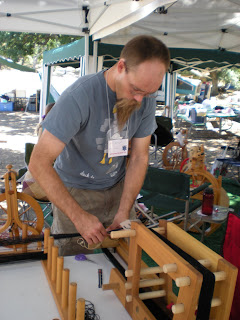My current project started life on another loom, borrowed from my friend Ellen. You can see pictures of the loom (and of the beginning of this project) at her Warp Weighted Loom blog. After a while, I started feeling guilty about having her loom for so long, so I decided I needed a warp weighted loom of my own.
It looked to me that Ellen’s design would be fairly simple to construct with a power saw and a drill press. Unfortunately, I don’t do hardware, only software, and the only power tools I possess are sewing machines. So I asked my friends Sean and Mary Ann to help me build a loom.
The first thing you need to know about Sean and Mary Ann is that everything they do, they do very, very well. It’s a combination of talent, intelligence and careful planning. The other thing you need to know is that they never do anything half-way. Sean and Mary Ann came over to take a few measurements off of Ellen’s loom while it was set up in my kitchen, and discuss any modifications I wanted. It quickly became clear that I wasn’t going to get a loom made of cheap pine from Home Depot. Also that more equipment than a chop saw and drill press would be needed.
Sean picked out some beautiful ash wood from the lumber yard. We spent a weekend in their shop using power tools I didn’t even know existed. Sean and Mary Ann were kind enough to let me pretend that I was helping – not just getting in the way. By the end of the weekend I had a beautiful loom made to my personal specifications made out of ash wood, with mortise and tenon joints.
A traditional warp weighted loom leans against a wall. I needed a loom that was free standing – I don’t have any empty wall space that isn’t a sliding glass door. I also needed a loom that could be disassembled and transported so I could use it for classes and demos. So my loom has a back upright that is hinged to the front. There are two cross pieces in the back and one in the front, that peg to the uprights and stabilize width of the loom. The cross pieces on each side hold it open. The loom breaks down into (mostly) flat pieces and a few pegs that I can easily transport in my minivan.

The top (cloth) beam must be braked in some way to keep it from unrolling under the weight of the warp. We decided to do this by shaping the beam into an octagon that fits snuggly into the supports.

I’m particularly proud of the heddle rod supports. They are based on an archaeological find from Trondheim, Sweden, circa 1120 – 1200 a.d. The original is pictured on page 232 of “Tidens Tand Nr. 5”, the report of the 4th NESAT Symposium. I enlarged the photo to the size needed and transferred it to the wood (Sean cut it out on the scroll saw).

So that’s the basic anatomy of my elephant. If you want of an elephant of your own there are instructions here at the House Barra web site
and here at Barbara atte Dragon's web site.


 Bridget wields the sword beater:
Bridget wields the sword beater:



















